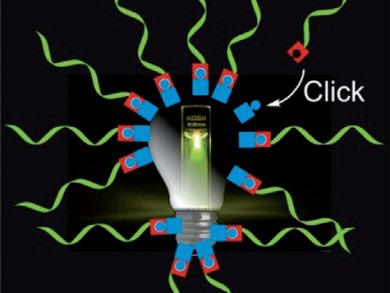Upconverting nanoparticles (UCNPs) have the unique property of showing visible luminescence when excited in the near-infrared region.
Plain UCNPs have no biorecognition capabilities, but a collaboration between researchers from the Karlsruhe Institute of Technology, the University of Regensburg, and the University of Würzburg, all Germany, has resulted in UCNP surface functionalization with single-stranded DNA oligonucleotide sequences. This DNA conjugation makes the particle soluble in water and enables it to recognize its counter strand. Such UCNPs are capable of nonspecifically crossing cell membranes.
DNA was covalently conjugated to the surface of the UCNPs through “click” chemistry via the copper-catalyzed alkyne azide cycloaddition (see scheme).
.gif)
The team demonstrate that DNA conjugation can be achieved in quantative yield by this method, and that excitation in the near-infrared region yields bright luminescence of the DNA conjugates in the visible range. These UCNPs can be used for live cell imaging in the near-infrared, where the UCNP–DNA conjugates can be considered to act as a nano-sized lamp.
Images: © Wiley-VCH
- DNA “Nanolamps”: “Clicked” DNA Conjugates with Photon Upconverting Nanoparticles as Highly Emissive Biomaterial,
M. M. Rubner, D. E. Achatz, H. S. Mader, J. A. Stolwijk, J. Wegener, G. S. Harms, O. S. Wolfbeis, H.-A.Wagenknecht,
ChemPlusChem 2012.
DOI: 10.1002/cplu.201100055
This article is available for free as part of the ChemPlusChem free trial.




